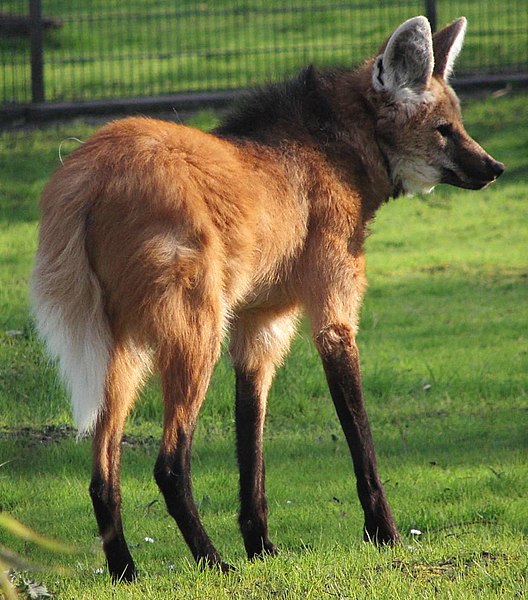Hello ladies and gents this is the Viking telling you that today we are talking about
MANED WOLF
The maned wolf is the largest canid of South America. Its markings resemble those of foxes, but it is neither a fox nor a wolf. It is the only species in the genus Chrysocyon (meaning "golden dog").
It is the largest canid in South America, with a weight between 20 and 30 kg, and reaches up to 90 cm at the withers. Its long, thin legs and dense reddish coat give it an unmistakable appearance. The maned wolf is a crepuscular and omnivorous animal adapted to the open environments of the South American savanna, with an important role in the seed dispersal of fruits, especially the wolf apple (Solanum lycocarpum). The maned wolf is a solitary animal. It communicates primarily by scent marking, but also gives a loud call known as "roar-barking".
This mammal is found in open and semi open habitats, especially grasslands with scattered bushes and trees, in the Cerrado of south, central-west, and southeastern Brazil; Paraguay; northern Argentina; and Bolivia east and north of the Andes, and far southeastern Peru (Pampas del Heath only). It is very rare in Uruguay, possibly being displaced completely through loss of habitat. The International Union for Conservation of Nature lists it as near threatened, while it is considered a vulnerable species by the Brazilian Institute of Environment and Renewable Natural Resources.
The species was described in 1815 by Johann Karl Wilhelm Illiger, initially as Canis brachyurus. Lorenz Oken classified him as Vulpes cancosa, and only in 1839 did Charles Hamilton Smith describe the genus Chrysocyon. Other authors later considered him as a member of the Canis genus. Fossils of Chrysocyon dated from the Late Pleistocene and Holocene epochs were collected in one of Peter Wilheim Lund expeditions to Lagoa Santa, Minas Gerais (Brazil). The specimen is kept in the South American Collection of the Zoologisk Museum, Denmark. Since there is no other record of fossils in other areas, is suggested that the species evolved in this geographic region.
The maned wolf bears minor similarities to the red fox, although it belongs to a different genus. The average adult weighs 23 kg (51 lb) and stands 90 cm (35 in) tall at the shoulder, has a head-body length of 100 cm (39 in) with the tail adding another 45 cm (18 in). Its ears are large and long (7 inches).
The maned wolf is the tallest of the wild canids; its long legs are likely an adaptation to the tall grasslands of its native habitat. Fur of the maned wolf may be reddish-brown to golden orange on the sides with long, black legs, and a distinctive black mane. The coat is marked further with a whitish tuft at the tip of the tail and a white "bib" beneath the throat. The mane is erectile and typically is used to enlarge the wolf's profile when threatened or when displaying aggression. Melanistic maned wolves do exist, but are rare. The first photograph of a black adult maned wolf was taken by a camera trap in northern Minas Gerais in Brazil in 2013
and as always have a chilled day from the Viking.

Comments
Post a Comment